Renault Triber Review By: Syed Shiraz
“Where’s your Renault Triber Review“, a friend asked me on WhatsApp. “Writing. In fact, I have started the review with your query itself“, I replied. She has been impatiently following up with me for my review ever since the car was launched. In her late 20s, she is a movie director who, along with her partner, and a lot of filming equipment, needs to travel frequently, that too mostly in the mountains. She has a budget of ten lakh rupees. Tops. Right now, she is using a Santro with the rear seats folded to make space for all the luggage and gear (drone, multiple tripods, etc.). The problem arises when they have to take even just one person along. Separate travel arrangements for him and his gear have to be made.
There’s another friend who connected to know my verdict of the Triber. He has two children (and a wife too, of course), and has been using a Wagon R since 2006. He doesn’t really “need” a bigger vehicle as of now, but he aspires to own an SUV, and the Triber has really caught his eye. This should also tell you the masses’ definition of an SUV.
Two very different needs and aspirations there, and I am sure there would be buyers with more varying objectives too. However, there’s one thing the majority of all buyers would have in common: they all would be upgrading from cars like the Wagon R or Santro, and are looking at the Baleno or i20 as their next purchase. Therefore, this Renault Triber Review will cater to such buyers only, and not to window shoppers who lust after the Renault Clio V6 Sport or Megane RS Trophy-R.
Renault Triber Review: How does it look?
Fabulous, in one word. View it head on, you’ll love it; view it from the front-three-quarters angle, you’ll love it even more! Otherwise too, in profile and from the rear, the design is palatable. I won’t talk about the individual components and features like the muscular bonnet, raised roof, body cladding, shoulder line, neckline, cleavage, lower lip, upper lip, moustache, etc., as I feel it’s redundant because you do have eyes (I’m taking the liberty of assuming that you do, since you’re reading this) and by now you would have already noticed everything about the design from the pictures and videos that have flooded the web ever since the Triber broke cover. I am just here to tell you how it looks and feels in real.

Well, it looks pretty darn substantial, I tell you, despite being a sub-four-meter car! You won’t ever mistake it for a hatchback. It looks BIG and imposing, but without being ugly or threatening. In fact, if you see it approaching from the opposite direction, you might go “Is that a Duster? Yes, it is. No, it’s not. Ermm, it is. Okay, it’s a new Renault. It’s the Triber!”


The road presence is fantastic, and the photographs below should drive the point home. I also made a short video clip to show how it fares against the Maruti Suzuki Ertiga, size wise.



Please do note though that our test vehicles came with the optional 15-inch wheels, while 14-inchers are what you get across all variants as standard.
Renault Triber Review: What’s the INSIDE Story?
The pun (if you get it, that is) above is not just for the heck of it. It indicates that not only will I tell you everything about the Triber’s in-cabin experience, I’ll also touch upon the “hows” and “whys” behind it. As in, wherever possible, I’ll also add “how” Renault was able to manage something or “why” it wasn’t able to manage something. But before I begin this section, let me take you back to my Renault Lodgy review, where I had first mentioned that it was Renault that invented the MPV.
The Triber isn’t an MPV, and Renault isn’t claiming it to be one either; however, that reference was just to reiterate that this manufacturer was the first in the world to understand the importance of space and flexible seating/cargo options. Therefore, don’t be surprised when I unravel one USP after another of the Triber’s cabin. “Space For Everything” is Renault’s tagline for the Triber, and there’s actually so much of it that it can even accommodate your girlfriend/wife AND her tantrums. I mean, just hand over the Triber’s key (or the Smart Access Card if you’ve bought the top variant) to her whenever she says she needs space.
Renault Triber Review: Dashboard & Switchgear Quality
But let’s not skip directly to the space, seating, and storage in this Renault. Let’s talk about how it feels when you first step inside; what you’re greeted with when you first open the door, and whether your surroundings make you feel special. Let me answer the last one first: yes, they do (if you do not agree, go back to the second statement of the third paragraph of this story). Neat and classy were the first two words that came to my mind upon stepping inside for the first time. Ergonomic, uncluttered, understated, and sturdy were the next four.

So there’s no chandelier hanging from the ceiling; the steering wheel doesn’t retract and touch your feet to take your blessings when you open the door; there are no wine glasses popping out on a tray from the dashboard, and there aren’t any rose petals strewn on the seats either. Thankfully, there are no faux wood inserts either.
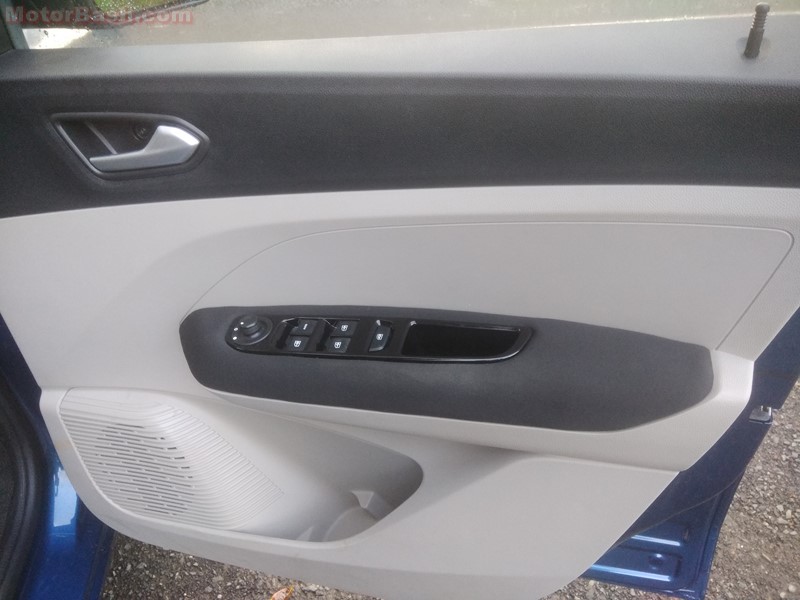
What you get instead is a dashboard that has a very clean, symmetrical, design that is not only beautifully pleasing to the eye, but is also an ergonomic boon.
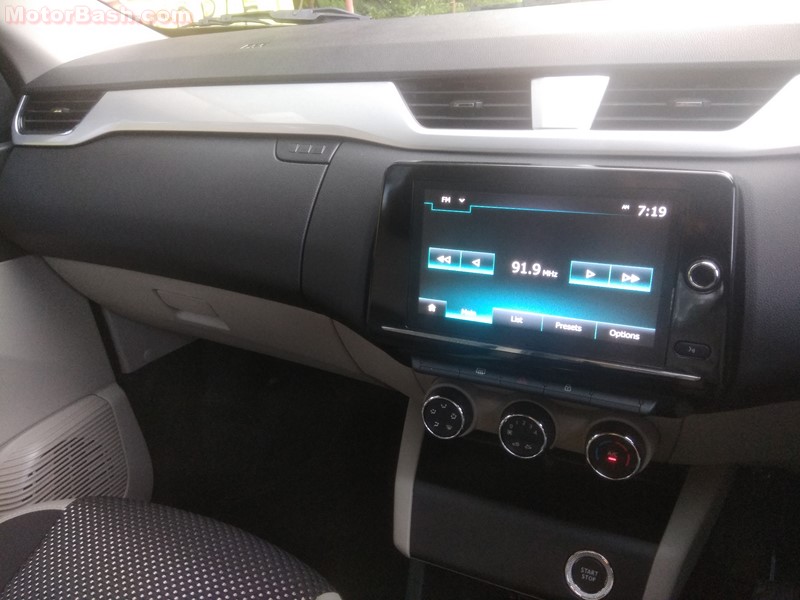
All controls fall naturally to hand, and I love the fact that no switch, stalk, lever, button, etc., felt flimsy to operate. There is that tiny bit of heft involved in operating even the smallest switches, especially the ones between the touchscreen and AC dials, and that’s reassuring! This is a very well put together cabin.
Renault Triber Review: Storage Space
And then comes the storage space. First off, all four doors can take in one-liter water bottles each. Then you have two gloveboxes—upper and lower—where the bigger one (lower) is cooled. Yes, you may keep your chocolates in it.

Plus, there’s another cooled compartment between the front seats, behind the gear lever, that can hold eight 500 ml water bottles! So you’re carrying eight liters of water for seven occupants. That should suffice for even the thirstiest of crows amongst you.


There’s also space below the AC dials to keep your phone, and then a deep one below the Start/Stop button, which you can use for wallets, more phones, etc.

Even the last row of seats have small cubbyholes where you can store toffee/chocolate wrappers until you find a bin to dispose them off properly. There’s also a slim tray below the driver’s seat. I haven’t tested any car by any manufacturer that offers these many storage places, and I haven’t even talked about the boot space yet! Space for everything? You bet!
Renault Triber Review: Seat Comfort | Front Seats
Before I talk about the boot space let me quickly address the seat comfort. The seats all around appear thin, and they are, but, surprisingly, there is zero compromise on comfort. The front seats are very comfortable and I don’t think anyone of any stature or build would find it lacking in any department or constricting in any manner. Under-thigh support is good, and it’s the same story with lateral support and the overall cushioning. There’s ample headroom, even for six-foot-plus drivers and passengers. How would I know? I saw more than two such fellow journos/bloggers sitting comfortably in the Triber, and their heads were still a good couple of inches away from carving out a sunroof.

It’s a comfortable place for shorties like me behind the wheel too, as you sit high in this vehicle and are able to see outside without craning your neck or lifting your bum even under the tightest situations. The big glass area all around helps massively as well! But if you’re someone who had bribed to get your driving license, fret not, there’s a rear-view camera, along with reverse parking sensors (three), of course, to help you reverse in and out of parking spots easily. The only minor irritant for some maybe the fixed headrests on the front seats, whereas both the second and third rows get adjustable units! I didn’t find that to be an issue for my height though—neither in the driver’s seat, nor in the passenger seat.
Renault Triber Review: Seat Comfort | Second Row
But it’s the second row of seats where the party starts! It’s not a single bench, but a 60:40 split arrangement, which, in addition to the regular fold and tumble, can be swiveled forward to generate more legroom for the third row passengers or pushed back if charity begins at home for the second row passengers. You won’t always need to do that as there’s good legroom to begin with even when all seats (front and second row) are set at the mid position of their fore and aft movement range. The seat squabs are big so under-thigh support is good even for tall passengers, and there’s enough shoulder room for two bouncers, and a slim model/singer/influencer in the middle. Three bouncers though will be a crowd, and a fight.

The headroom is even better than in the front as this is where the roof starts getting higher. It has to, because, like in the Lodgy, the middle row here as well is placed higher than the front seats, and the third row is again set higher than the second. Essentially, it’s a stepped floor, which is so cleverly designed that you might not even notice it at first. It has two immediate advantages. Since you sit higher than the person in front, your line of sight is much better than what it would have been otherwise, and you do not feel claustrophobic. The large glass area all around, as mentioned earlier, also helps.
The second benefit is that the high-seat low-floor combo (the seat is mounted on the elevated floor whereas your feet rest on the lower front section) means that taller people do not sit in an uncomfortable knees up position and their thighs are resting properly on the seat. Shorties like me shouldn’t be worried either as the seats are not that high that they would have our legs dangling in the air.

The backrests of both sections of the second row can be reclined as well, and that too to a great extent. The fellow journo, who was sitting right behind me while I was driving, said, “This is really where my dad would want to sit. It’s very comfortable, and would keep him happy.” Speaking of elderly people, I would also like to mention that the Triber’s doors are big and open really wide, making ingress and egress for all a breeze. It also makes getting in the third row easy too, and the two-finger fold-and-tumble mechanism of the left-hand side middle row seat makes it further easier. I have made short clips to demonstrate that, and more, and I’ll insert them somewhere down below.
Renault Triber Review: Seat Comfort | Third Row
The two seats in the third row turned out to be more comfortable than I had imagined. There’s no dearth of shoulder room and headroom (yes, thanks to the raised roof), however you do sit in a knees up position here as your feet rest on the elevated section of the floor.
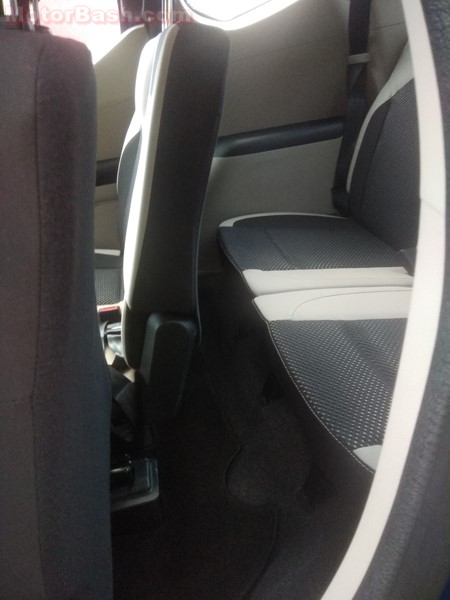
But both occupants do get an armrest each, a 12-volt socket, and two AC vents in the roof! I didn’t expect that, especially when there are more than a handful of costlier hatchbacks and sedans that do not provide AC vents for even the second row. The second row gets the vents in the B-pillars.
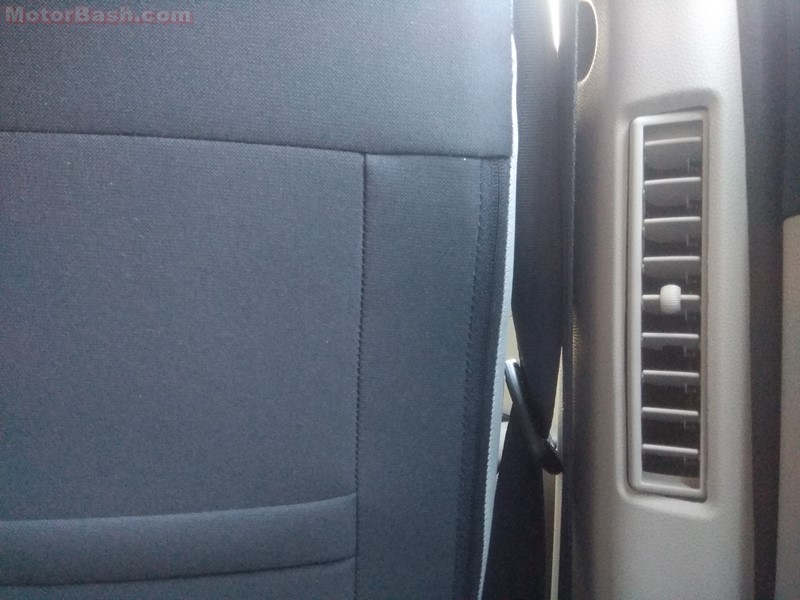
So you have four vents at the front, and four for the second and third rows. Unlike a few cars where the rear vents are just an extension of the HVAC unit installed in the dashboard, the Triber’s second and third row AC vents get a dedicated cooling coil like, say, the Innova does. In the Triber though, it’s placed under the front passenger seat.

The blower control is between the front seats, which is easily accessible if you’re sitting the second row.

In layman’s terms, the Triber has a dual-AC like in the five times expensive Innova, whereas the other hatchbacks in the Triber’s range get a regular single AC. Therefore, the cooling is brilliant in the Triber, and I foresee prospective buyers coming out impressed after a test drive.
Renault Triber Review: Boot Space
And now we come to the boot space of the Renault Triber. Since you must have already heard, read, and seen a lot about it, I’ll keep this one short. With all seats up, the boot will hold three schoolbags, and you should be able to shove two or three more on top of them from inside of the car. That’s good news if you live in a joint family and have to drop your and your brother’s kids to school in the morning. You won’t actually need the boot though as children keep their schoolbags either on or between the seats, but my job is to tell you the options you have, and also how you can discipline your kids. I don’t have any of mine yet, but that’s a story for some other day.

The biggest surprise for me in the boot space stakes is that the Triber has more of it than even the Ertiga when you convert both cars into five-seaters! With the rear seats folded in the Ertiga, you get 550 liters of boot space, whereas it’s a whopping 625 liters in the Triber as a five-seater! How’s that possible, you ask? Well, when you factor in that the Triber is wider (1739 mm) than the Ertiga (1735 mm), and that despite being a sub-four-meter car the Triber’s wheelbase (2,636 mm) is longer than even the Creta’s (2,590 mm), Seltos’ (2,610 mm), etc., you’d calm down, take a sip of the drink you’re having, and realize that yes it seems possible.

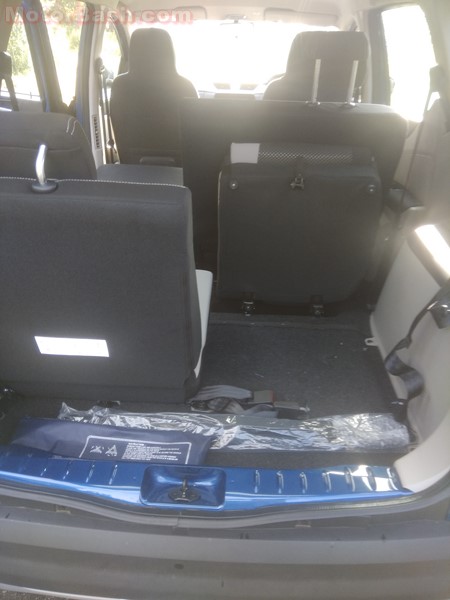
Also, you can remove the rear seats of the Triber completely, which you cannot in the Ertiga. And since I’ve mentioned the Creta and Seltos here, let me give you the boot space figures for these two five-seaters as well: 400 liters and 433 liters, respectively. The Hyundai Elite i20 and Maruti Suzuki Baleno? Not even remotely close, sir! In fact, the figures are hilarious in comparison. The i20’s is less than half at 285 liters whereas the Baleno’s is 339 liters. Since 339 plus 285 equals 624, the Triber has a liter more boot space than both the i20’s and Baleno’s combined!
Renault Triber Review: Performance
The Internet has spawned pseudo-experts on every subject. Awareness is one thing, knowledge is another, while blabbering on the basis of your superficial understanding of a subject is another level altogether. Sadly, we get to see the last kinds more nowadays. I say that because it’s this majority that has for several decades gone to weddings stuffed with ten other people, fruit baskets, and wedding presents in a 34 hp, 59 Nm, 800 kg petrol eight-seater (Maruti Suzuki Omni), but is sceptical of a one liter petrol (with variable valve tech), 71 hp, 96 Nm engine’s ability to pull a 947 kg vehicle with seven people onboard. Lovely!

That said, they still do have a point, unlike a few idiots in the auto PR industry who invite clods and zombies in the name of “influencers” on media days. Don’t worry if you didn’t get the second part of the last sentence. It’s not for you. It’s for the PR folks of a few other manufacturers who might be reading this. I was just glad that I spotted none of them (the influencers, I mean) during the Triber drive.
Renault Triber Review: Engine, HP, Torque Talk & Ride Quality
Anyway, back to the Triber’s engine, and let me clear the air once and for all for everyone. A senior official at Renault, a French gentleman, while addressing everyone present, said that 90 per cent of the torque is available from under 2,000 rpm in the Triber. Now I do not have a dyno to either ascertain or refute that claim, but I can give you a seat-of-the-pants conclusion, which is that he ain’t exaggerating. And I’ll give you an example so that you can have a clear perspective.
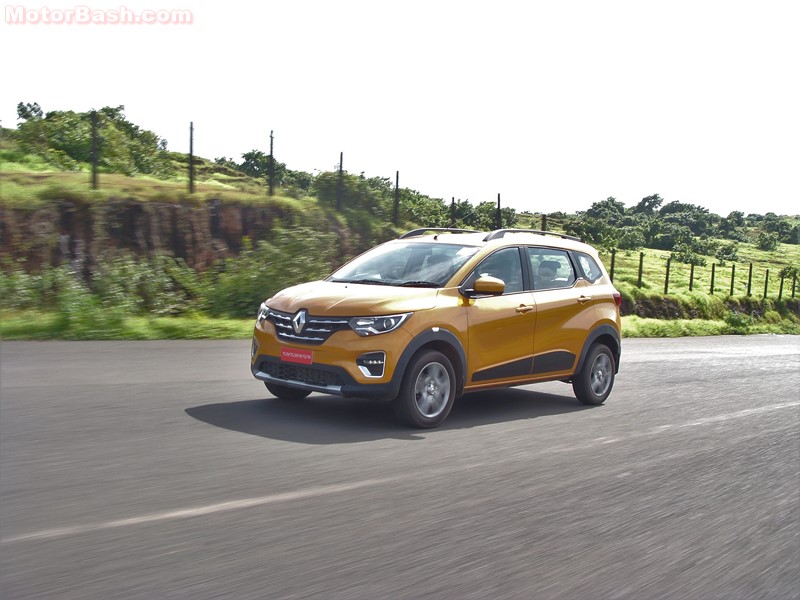
In the past nine years, I have driven my aunt’s 2010 Honda City 1.5 V MT the most. It’s a great car, however, every time I have to negotiate a speed breaker, irrespective of the number of passengers in the car, I have to use the 1st gear to get going again. And that’s a 1.5 liter, 146 Nm engine pulling a light (for its segment) 1,100 kg car. There are two reasons for that: 1) Due to the City’s low ground clearance, you have to slow down to almost zero km/h to avoid scraping it, and 2) since the peak torque is delivered at 4,800 rpm, you have to downshift to 1st to avoid stalling it.

For the record, I NEVER had to choose the first gear in the Triber while traversing the speed humps in Goa, irrespective of their size. Heck, the fellow journo even tried tackling them in 3rd, and with just a hint of protest, the Triber soldiered on! It’s not all torque though; the Triber’s best-in-class 182 mm ground clearance also helped as we could carry decidedly better momentum over those unwelcoming road protrusions. And you can do that with seven people onboard as well, thanks to the excellent ride quality of the Triber!
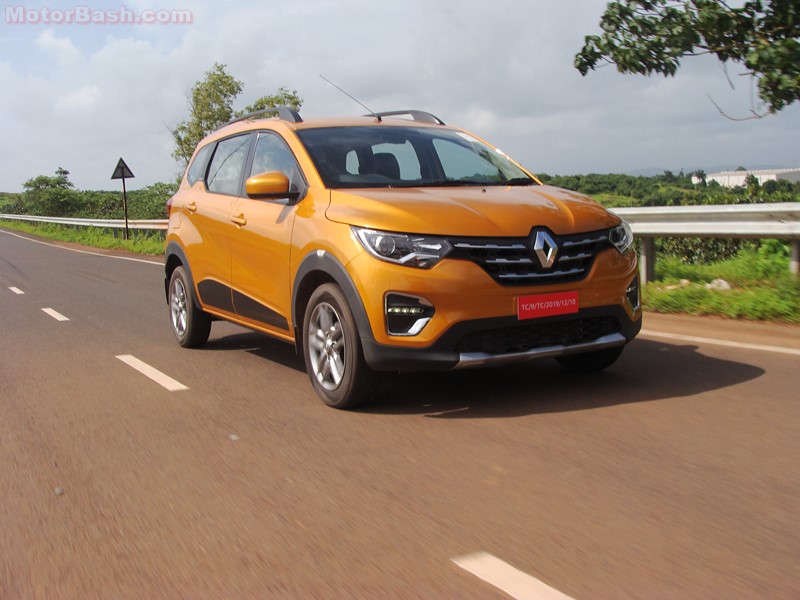
But what about places and situations where you cannot use the advantage of momentum? I’ll again give you a live example, and not just a verdict and ask you to take my word for it. So while attempting the acceleration runs (two occupants, and AC working in all three rows!) at one of the still unused-by-corporates sections of the Verna Industrial Area in Goa, I had to reverse up a steep incline for more than a hundred meters. And I could do that on part throttle and didn’t even have to touch the clutch a bit (after releasing it fully at the beginning, of course) for increasing or decreasing the speed. I could lift off and again get back on the throttle smoothly without using the clutch at all. It didn’t bog down or protest, whatsoever! We were pleasantly surprised yet again.

Now, I couldn’t find five people to act like dummies, but I reckon that the Triber’s pulling behaviour in such situations wouldn’t change drastically with seven full-sized occupants. Stuck in crawling traffic on the incline of a flyover with a full load of passengers? Don’t fret, you’ll manage. Will it be effortless? No. Will it be frustrating? No. Will it be manageable? Absolutely.

And I have covered just one part (the pulling power) of it. Two more parts remain: overtaking and comfortable cruising speed. Let me talk about overtaking first: you will almost always have to downshift to overtake! I know I make it sound like a big deal, but you know it isn’t. If you’re not a novice, that is. I mean, you get to know the best gear for overtaking (it would be different for overtaking at different speeds, but you get the point, right?) within 10 to 15 minutes of driving a car, any car.
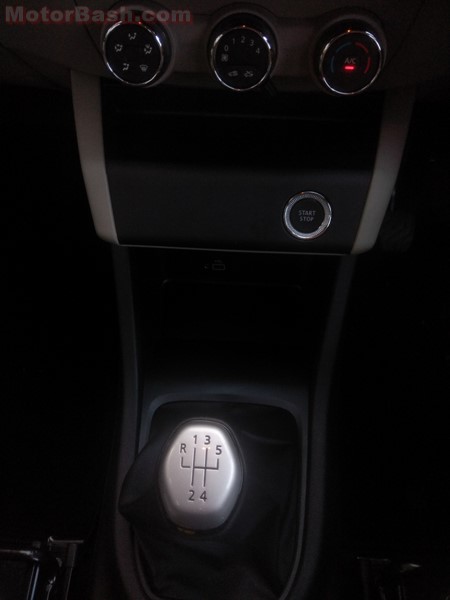
Therefore, when you start driving the Triber, you understand quickly enough that 3rd and 4th cogs are your best allies. So if you’re in 5th, shifting down to fourth would help on most occasions, but it’s the third that will give you the most satisfaction, albeit with a lot of engine noise for those few seconds.

Don’t worry about the noise though, as you hear it inside the cabin only when you operate the car with a heavy foot. NVH levels are good, and Renault engineers have used insulation material on the front fenders too, which is not something you see in every car. Also, I must add that it’s only you and the front passenger who get to experience the harshness of the engine sometimes; the second and third rows are a quiet affair. Your family members will be thankful to you. And to Renault.

Coming to the last part of the one-liter/seven-seater full disclosure now—the comfortable cruising speed. To determine that, you either need to be on the expressway, where you can sustain high speeds for a decent amount of time, or somewhere where you can at least touch the vehicle’s top speed and come back. You cannot do either in a place like Goa as it doesn’t have straight, flat roads and if it does, do let me know.

Therefore, I could drive the Triber only on narrow, but winding, roads of Goa. However, despite driving at a relaxed pace, I was continually seeing 60 to 75 km/h on the speedo. I tried a 0-100 km/h run at Verna, where the first half of the road, up to around 40-50 km/h, is a decline, and the second half is immediately an incline.
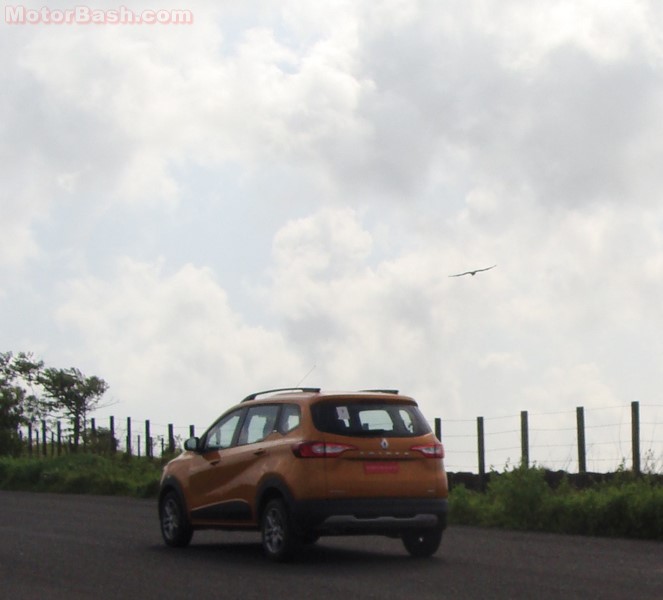
The Triber reached 97 km/h before a canine attempted suicide with shaky dedication. But the run, along with the rest of the drive, gave me a good idea about the Triber’s comfortable cruising speed. I feel the Triber, with seven occupants, can run all day between 80-100 km/h without any stress, and anything over 110 km/h might stress the engine, or the occupants might tell you to slow down due to the engine noise. But I should also tell you that it’s an absolutely silent cabin between 60-80 km/h in 5th gear.
Renault Triber Review: Fuel Efficiency
Did I cover everything you can in a short first drive? No, I didn’t tell you about the fuel efficiency and handling. The former is something you just cannot find in a short drive. And though the Triber’s fancy-for-the-segment instrument console does give you both types of fuel efficiency figures (instant and average), along with the distance-to-empty range in km, I don’t trust these figures (except the range indicator, which does give a good idea), no matter what car I am driving.

A tankful to tankful is the only proper way to determine the fuel efficiency of a vehicle correctly and that is what I’ll do someday in the near future with the Triber too. Until then, you may choose to take comfort in the ARAI figure of 20 km/l.
Renault Triber Review: Handling
Talking about handling, I would replace the word “handling” with “ease of steering” here, keeping in mind the intended buyer of this car. Why? Please go back to the last line of the third paragraph of this story. The steering is light, which means you won’t be getting tired driving this car even in the worst kinds of traffic. That light steering, coupled to a short turning radius, would also aid you in grabbing a vacant parking spot, quickly and easily, in congested and/or busy spaces, say, like a parking lot of your city’s most popular mall.

But does the light steering mean that an enthusiast, who buys this for his family needs, would need to kill the handling aficionado inside him forever? Thankfully, no. Because, even though the steering lacks feel and feedback, the taut suspension doesn’t allow too much body roll, making the early morning or midnight drives a fun affair. And the steering is adjustable for rake.

I made a casual Hindi video review just an hour into the drive and I remember saying in it that I did enjoy driving the Triber on the winding Goan roads. Oh, the braking is spot on too, even on less than perfect surfaces, thanks to ABS and EBD. Wait, I think I have a short clip of that too. Yes, I do. Take a look below:
Renault Triber Review: Miscellaneous
I am putting three video clips in this section. I want to show the headlight brightness, throw, and spread to you. I also want you get an idea of the sound quality of the music system. And I also want you to know the exact distance at which the Smart Access Card/Key unlocks and locks the Triber.
I also remember now that the wipers do not clean the entire windscreen. Yes, I know that it’s like that on most cars, but here a large patch on the passenger-side windscreen remains untapped. Thankfully, the driver-side section is attended to quite nicely by the wipers, so I won’t complain much.

Pro Tip: Always clean the entire windscreen yourself manually first and do not forget to clean the wiper blades too. The wipers primary job is not to clean your windscreen, but to keep your outward visibility clear by keeping the water away from the windscreen during rains. The washer fluid is to be used when you’re NOT at home and have to depend solely on it.
Renault Triber Review: Verdict
At a time when manufacturers do not hesitate in calling their regular hatchbacks as crossovers after slapping on some rubber and plastic on the sides, Renault India is playing a bit humble here by not calling the Triber an MPV or even a crossover. They just want you to look at it as a hatchback with two extra seats. They aren’t wrong, but I do not think that’s the best way for a buyer to either look at it or even assess his own needs. I think you can look at the Triber in just the following two ways:

1) a 7-seater whose top-end variant (the one we, and everyone else, drove) at 6.49 lakh rupees is more than a lakh rupees cheaper than the base version of the Ertiga, or 2) a 5-seater with more than double the amount of boot space than almost all hatchbacks, and one whose top variant still costs about as much as the second lowest trims of the i20 (Magna+ is 6.28 lakh, while the top-end Asta (O) costs 8.09 lakh) and Baleno (Delta petrol is 6.36 lakh, while the top-end Alpha petrol costs 7.58 lakh. All prices mentioned are ex-showroom, Delhi).

Two airbags are standard across all variants of the Triber, whereas the top-end RXZ version we tested comes with two more (side airbags for the front passengers). This Renault will affect every hatchback out there, and then some. Heck, it will even hurt the Ertiga. I think it will also compel people, who were saving for vehicles like the EcoSport and Creta, to chuck saving and buy the Triber instead.

Renault seems to have answered a lot of prayers with this one. My congratulations to them for their third blockbuster.



Awsomme and well detailed review. Covered all the points prospective buyers looking for. Waiting for turbo charged variant to be launched and reviewd.
Thanks for sharing this very well-written and worth reading article.
Wish to see more in the coming days.